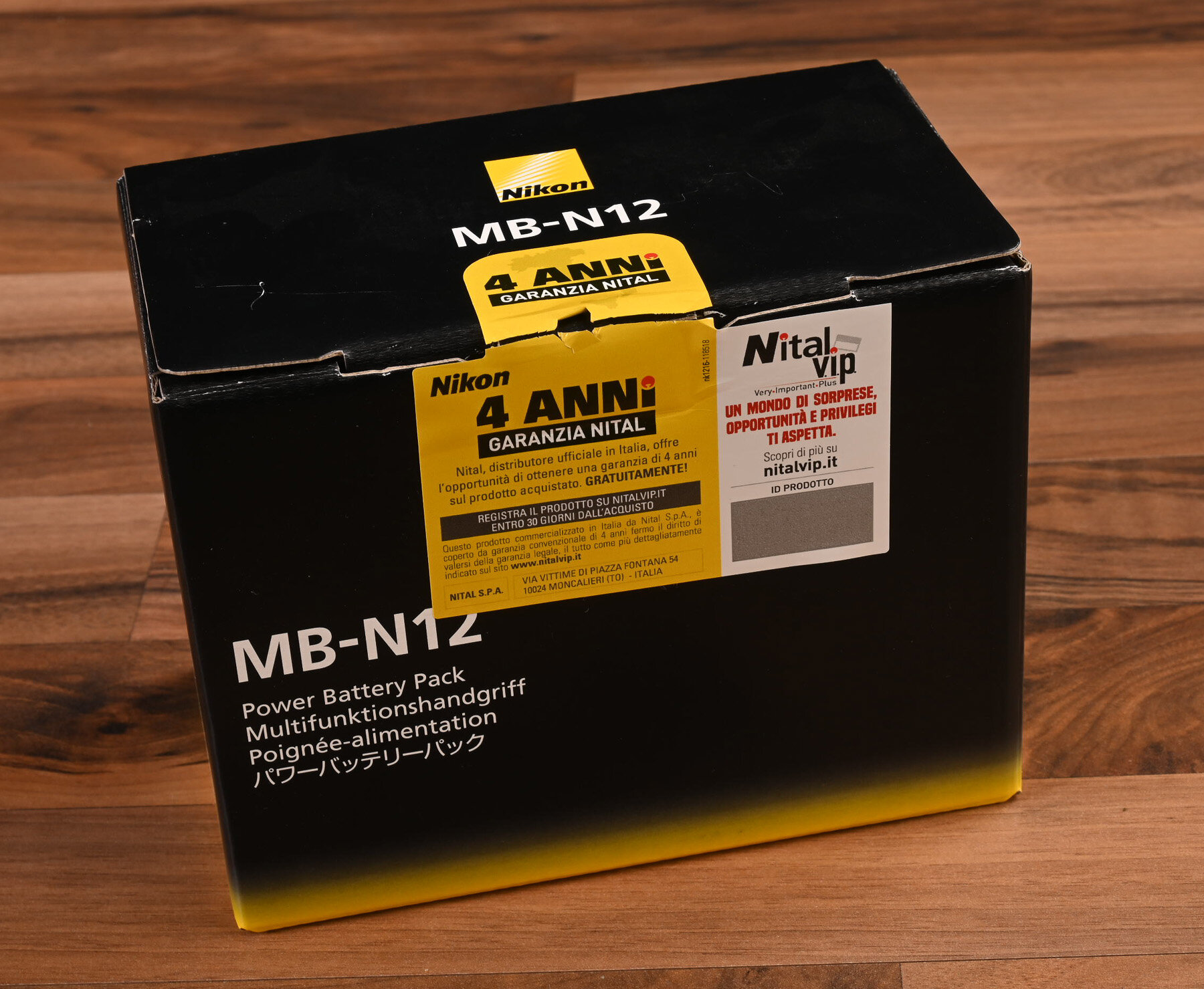Classifica
Contenuto Popolare
Mostra il contenuto con la massima reputazione di 06/01/2024 in tutte le aree
-
La sommatoria delle letture degli oltre 1.000 articoli di Nikonland.it ha appena superato la barriera dei 4.000.000 di visualizzazioni complessive9 punti
-
Gru PLS 2024 Clip_01 - 1080WebShareName.mov al pubblico ludibrio del resto queste cose si fanno per il piacere di creare un po' di reazione...di qualunque tipo5 punti
-
A seguito degli sciami di scosse telluriche, sono state sospese "temporaneamente " le attività produttive delle fabbriche di memorie di tipo NAND nel nord del Giappone. Sebbene queste non siano tra i maggiori produttori del settore, è possibile che si innescherà una catena di carenze di prodotti che facilmente porterà a rincari e/o ritardi in tutto il settore. Possibile che nei prossimi mesi si assista a rincari sui prezzi di SSD e schede di memoria di tutti i generi, specie nelle fasce più alte. Suggeriamo di procedere ad eventuali acquisti in sospeso sui prezzi migliori di oggi.4 punti
-
Lexar presenterà le sue CFexpress CF 4.0 al CES di Las Vegas la prossima settimana. I prodotti includono schede CFexpress all'avanguardia, SSD ad alte prestazioni di prossima generazione, moduli di memoria ultraveloci e altro ancora Scheda professionale CFexpress™ 4.0 tipo B serie DIAMOND Scheda professionale CFexpress™ 4.0 tipo A serie GOLD Scheda professionale GOLD microSD™ UHS-II SSD portatile ARMOR 700 SSD professionale NM1090 M.2 PCIe Gen 5 NVMe™ con dissipatore di calore SSD professionale NM800 PRO M.2 2280 NVMe™ con e senza dissipatore di calore GIOCA SSD M.2 2230 PCIe 4.0 ARES RGB DDR5 8400MT/s San Jose, CA, USA, 4 gennaio 2024—Lexar, marchio leader a livello mondiale di soluzioni di memoria flash, è entusiasta di rivelare la sua linea di prodotti che sarà presentata al CES di quest'anno a Las Vegas, Nevada. Con prodotti che spaziano dal suo collaudato portfolio di fotografia e videografia professionale alla sua solida linea di giochi, sarà in mostra l'ampiezza dei prodotti Lexar. Lexar presenterà la sua serie DIAMOND di schede professionali CFexpress 4.0 di tipo B all'avanguardia che sfrutta l'ultimo PCIe Gen 4 per le prestazioni potenti e le efficienze di post-produzione accelerate che i professionisti richiedono: un massimo velocissimo. velocità di lettura di 3600 MB/s e max. scrittura di 3300MB/s. 1 Per gli utenti di apparecchiature di tipo A, Lexar mostrerà la scheda Professional CFexpress 4.0 di tipo A serie GOLD. Utilizza inoltre la tecnologia PCIe Gen 4 ed è la scheda CFexpress di tipo A più veloce al mondo con max. velocità di lettura di 1800 MB/s e max. velocità di scrittura di 1650 MB/s. 1 Verrà visualizzata anche la scheda Professional GOLD microSD UHS-II. Consigliato da GoPro per l'uso con le loro action cam, offre max. velocità di lettura di 280 MB/s e max. velocità di scrittura di 180 MB/s 1 ed è disponibile con capacità fino a 256 GB. Un altro punto forte per il pubblico professionale sarà l'SSD portatile ARMOR 700. Costruito in modo robusto, è pronto per l'uso anche negli ambienti più difficili e offre prestazioni incessanti e affidabilità superiore con max. velocità di lettura e scrittura di 2000 MB/s. 1 Dal punto di vista dei giochi, Lexar rivelerà l'SSD professionale NM1090 M.2 PCIe Gen 5 NVMe con dissipatore di calore. Dotato di prestazioni PCIe Gen 5 con max. velocità di lettura di 12.000 MB/s e max. velocità di scrittura di 11.000 MB/s, 1 è quasi due volte più veloce di PCIe Gen 4. 2 Lexar presenterà anche il pluripremiato SSD NM800 PRO M.2 2280 NVMe e la sua ultima versione dell'NM800 PRO che include un dissipatore di calore integrato , con capacità fino a 8 TB. L'SSD PLAY M.2 2230 PCIe 4.0 racchiude grandi prestazioni in un formato ridotto, perfetto per console di gioco portatili e laptop compatibili con M.2 2230. Fornisce il massimo velocità di lettura di 5200 MB/s e max. velocità di scrittura di 4700 MB/s, 1 e sfrutta la cache dinamica SLC per mantenere rapidi i tempi di caricamento e download. Lexar mostrerà anche la sua velocissima DRAM da gioco, ARES RGB DDR5, che arriva a 8400 MT/s e con timing fino a CL40.4 punti
-
Lancio sul mercato : autunno 2018 con le Nikon Z7 e Nikon Z6 con cui costituisce kit Motore di messa a fuoco : STM Stabilizzatore integrato : NO Distanza minima di messa a fuoco : 24cm Diaframma a 7 lamelle 14 lenti in 11 gruppi passo filtri 72mm Rivestimento: Trattamento Nano Crystal Coat, trattamento al fluoro Diametro massimo di 77,5 mm x 88,5 mm di lunghezza circa per 500 grammi di peso *** Presente in listino fin dal lancio della prima Nikon Z nell'autunno del 2018, questo zoom standard sovverte tutte le considerazioni che ci hanno portato ad evitare nei decenni passati questo genere di obiettivi quando offerti in kit. Alla prova dei fatti è di una classe del tutto superiore a quanto eravamo abituati. Una prima occhiata allo schema ottico lo fa sospettare. abbiamo elementi speciali in numero inusitato per questa categoria di obiettivi che si traducono in immagini di buona qualità. Anche la costruzione che sulle prime sembrerebbe plasticosa, nasconde proprietà non comuni nei kit, come la tenuta con guarnizioni ed anelli alle infiltrazioni di polvere e umidità. Cosa che ne consente un uso tranquillo con le altrettanto robuste Nikon Z. lo spaccato di tutte le guarnizioni di un kit Z7 + Nikkor Z 24-70/4 S *** Adatto ad ogni genere di fotografia si fa apprezzare per la relativa compattezza (in relazione all'attacco Z che non autorizza miniaturizzazioni estreme). Buono per qualsiasi genere, sottolineiamo l'eccellente distanza minima di messa a fuoco che favorisce anche fotografie ravvicinate. La nitidezza è ottima al centro, migliore alla minima focale, in ritirata ai bordi e alla focale massima. Le caratteristiche generali vengono consegnate dalla fotocamera già corrette al software di sviluppo. E' possibile che la focale minima sia leggermente inferiore al dichiarato, per consentire una riduzione indolore della distorsione. Ma, sono caratteristiche di compromesso che stanno insite in un progetto del genere. Che in kit viene spesso offerto ad un prezzo estremamente conveniente e si trova sempre sull'usato a prezzi interessanti. Mentre il listino del solo obiettivo ci è sempre sembrato irragionevole. Qui presentiamo quattro scatti, tutti diversi tra loro, tra cui due focus-stacking, attività in cui questo obiettivo si è mostrato estremamente indicato, tanto da non far desiderare quei macro che nel primo periodo di uso delle Nikon Z non erano nemmeno disponibili. vedute fiori una Alfa Romeo Giulia Quadrifoglio in scala 1:18, edizione speciale una ragazza in camera da letto, in luce disponibile Quando è uscito questo obiettivo era unico e solo. Poi Nikon ha esagerato e adesso l'offerta di zoom 24-XXX o 28-XXX è addirittura esagerata, il che apre ogni tipo di scelta per il fotografo in base alle sue specifiche esigenze. Questo però non esclude di mantenere il 24-70/4 in utilizzo per chi già lo possieda, magari per compiti meno impegnativi e con sensori meno pretenziosi di quelli da 45 megapixel. Oppure di continuare ad acquistarlo con Z6 e Z5, specie con quest'ultima, preferendo il 24-70 al 24-50 per una pura questione di escursione focale. *** I test di Nikonland.it : Nikkor Z 24-70mm f/4 S : lo zoom base per Nikon Z Nikkor Z 24-70mm: quale scegliere ? e l'album dedicato dove gli iscritti possono caricare le loro foto migliori fatte con questo obiettivo :2 punti
-
CONFEZIONE il prodotto, è inutile nasconderlo, è del tutto analogo al battery grip MB-N11 proposto per le Nikon Z6 II e Z7 II. Lo stesso vale per la confezione che non presenta sorprese, sia nell'aspetto esterno che nell'interno. naturalmente per sfruttare la capacità di doppia batteria del battery-grip si dovrà acquistare almeno una seconda EN-EL15c. NIKONLAND RACCOMANDA L'ACQUISTO E L'UTILIZZO DI BATTERIE ORIGINALI NIKON. NON E' SUI POCHI EURO RISPARMIATI CHE E' IL CASO DI RISCHIARE FOTOCAMERE DA MIGLIAIA DI EURI DETTAGLIO Ma andiamo nel dettaglio. Esattamente come nel modello MB-N11 del quale questo replica sia l'architettura che le funzionalità generali, la contattiera che mette in comunicazione il grip con la fotocamera è rappresentata da un gruppo di pin dorati sulla sommità del protuberanza che va introdotta dentro alla Nikon Z8, ovviamente privata di batteria interna e del relativo sportellino copribatteria. l'impugnatura è ampia ed ergonomica. La solidarietà con la fotocamera è assicurata da diversi perni - oltre alla "falsa batteria" costituita dalla gamba verticale, mentre il blocco avviene per il tramite di un vitone azionato da una grossa ghiera avvitabile e svitabile con le dita della mano. i comandi verticali sono replicati. E' previsto un blocco per evitare azionamenti involontari con il palmo della mano destra. Il tastino funzione aggiuntivo è di default impostato su Compensazione della esposizione ma può essere riassegnato ad esempio alla modifica della sensibilità ISO. il posteriore presenta la replica del mini-joistick della Z8 e il tasto AF-ON. Resiste il comodo appiglio per il pollice. Come i due led che indicato la carica delle due batterie, denominate A (quella esterna) e B (quella interna). dettaglio della piastra di contatto col fondello della Z8 dettaglio del comodo alloggiamento dello sportellino del copri-batteria della Z8 che va rimosso prima di montare il battery-grip. In questo modo si evita di dimenticarlo chissà dove e poi doverlo comprare come pezzo di ricambio. dettaglio del pulsante di scatto verticale con il suo blocco di scatto. altri dettagli costruttivi. CONFRONTO CON LA Z8 e LA Z9 A vedersi da solo non si direbbe ma non è piccolo. Di fatto è la replica di quello pensato per fotocamere più piccole come Z6 e Z7 II. Ne differisce solo per dettagli. Sufficienti a rendere incompatibili i due modelli MB-N12 ed MB-N11 tra loro. Ciò comporta che in altezza il battery-grip MB-N12 aggiunge alla Z8 quei centimetri che la fanno diventare più alta della Z9. praticamente la Z9 arriva alla spalla della Z8 ... con il tacco a spillo. Se ciò aggiunge comodità di presa e tanto spazio per poggiare il palmo della mano destra, fa anche si che la Z8 così "carrozzata" diventi più alta, più ingombrante, più ... goffa. Probabilmente - non abbiamo verificato con la bilancia - anche più pesante. Perdendo di fatto tutti i vantaggi che la differenziano in positivo dall'ammiraglia. Lo scotto da pagare per guadagnare la presa verticale e l'autonomia aggiuntiva della seconda batteria. Non sfuggirà che l'aspetto più squadrato e un pò affilato delle linee laterali - indispensabili per guadagnare ogni millimetro indispensabile a mettere due batterie EN-EL15c per la lunghezza - corrisponda ad una peggiore ergonomia rispetto all'ammiraglia Z9 che è invece pensata per dare il massimo durante l'uso. FUNZIONALITA' Ma andiamo alle cose pratiche, perché questo accessorio non è pensato per l'estetica. Dovessimo dare un voto al design, a stento arriveremmo ad assegnare un INSUFFICIENTE. lo sportellino si apre a scorrimento e poi gira su se stesso. Cela la slitta che si sblocca con la levetta bianca. questo consente di estrarre la slitta completa con le due batterie che sono chiaramente montate in controfase tra loro. La prima, quella esterna, designata come A, entra ed esce a scorrimento, la seconda, designata come B, si incastra e può essere inserita o rimossa solo estraendo del tutto la slitta. La prima invece può essere estratta anche senza muovere la slitta, semplicemente premendo il blocco giallo come si farebbe con la batteria integrata nella Z8. Ma la differenza è che la batteria A può essere rimossa o sostituita " a caldo " senza spegnere la macchina, a condizione che la batteria B sia ancora carica. sostituendo la batteria A si può quindi continuare a fare ciò che si stava facendo senza interruzioni. Inoltre il battery-grip, dispone di una sua presa USB-C di ricarica. Attraverso quella, le batterie inserite nel grip possono essere ricaricate anche off-camera, avendo di fatto la possibilità di un caricabatterie doppio. La condizione stabilita da Nikon è che si abbia un alimentatore da almeno 30 Watt, meglio se con Power Delivery. innesto USB-C di un terminale di ricarica proveniente da un Baseus da 100 Watt con Power Delivery, con un mini-tester di verifica. Il battery-pack, come si vede in foto è separato dalla fotocamera ma la ricarica avviene comunque. E in questo caso viene ricaricata la batteria B, come evidenziato dalla relativa spia accesa. qui invece abbiamo l'operazione di ricarica attiva con il battery-grip montato sulla camera. La batteria B è carica mentre viene ricaricata la A. L'operazione avviene dalla presa USB-C del battery-grip, non della fotocamera. il menù della Z8, alla voce "Info batteria" evidenzia in ogni momento lo stato delle due batterie. In questo momento la B è al 100%, la A al 3% e necessita di ricarica. durante la presa di carica viene evidenziato il segno di presa di corrente per dire che l'alimentazione è collegata. Sia sul display superiore che su quello posteriore la ricarica assorbe 5 Watt a 15 Volt. E' più lenta di quella diretta dalla Z8 o da un caricabatterie dedicato. Ma lo stesso pienamente funzionale. Usando la Z8, quando la batteria A si sta scaricando appare il segno ROSSO a mirino, anche se la batteria B è ancora carica. Ma ad avvenuta scarica completa, si innesta automaticamente la batteria B, senza soluzione di continuità. Come detto, è sempre possibile, a condizione che la batteria B abbia ancora carica residua, sostituire al volo la batteria A scarica con un'altra carica. GIUDIZIO COMPLESSIVO Nell'uso il battery-grip è pienamente funzionale. L'autonomia della Z8 supera quella della Z9 con la sua enorme EN-EL18d e l'ergonomia complessiva ne guadagna, in particolare per lo spostamento del baricentro verso il basso, la presa più sicura con il palmo che ha tutto lo spazio che si vuole senza premere contro lo spigolo della parte inferiore della fotocamera. Ovviamente nell'uso in ripresa verticale, specie con obiettivi "importanti", non c'è paragone rispetto al corpo senza battery-grip. Di contro dobbiamo registrare, oltre al costo, non indifferente del MB-N12 (€399) e quello di una batterie aggiuntiva (€ 68), un ingombro complessivo che toglie ogni ragione di preferire la Z8 alla Z9 perché più compatta. La costruzione è di qualità ma la finitura complessiva meno raffinata di quella del corpo Z8 per non parlare di Z9. Senza nulla voler togliere al suo valore funzionale, sembra una soluzione di ripiego, pensata per chi ha proprio bisogno e non può farne a meno ma senza quelle particolarità che invece caratterizzavano il grip delle reflex professionali, come ad esempio, quello sensazionale della Nikon D850 che poteva integrare anche una batteria da ammiraglia al suo interno. Noi ne raccomandiamo l'acquisto a chi ne necessiti sporadicamente. Chi avesse bisogno permanentemente di questa soluzione, probabilmente troverà meglio soddisfatte le sue esigenze acquistando una Z9. Se già non ce l'ha. Se questo articolo vi è sembrato utile mettete un like. A voi non costa nulla ma per noi fa una grande differenza per capire quali siano gli argomenti che i lettori trovano più interessanti. Non abbiate timore ad aggiungere i vostri commenti1 punto
-
Gru? Oppure oche anche queste? Finalmente qualcosa di diverso ... Dicci della seconda camera, quella che ti inquadra: come l' hai impostata? Come l' hai pilotata? In remote oppure poi nel montaggio hai tagliato il surplus?1 punto
-
Qui di bestiale non c'e solo il video o le foto, ma anche Tu ! Il video e le foto sono bellissime, e la preparazione è veramente avvincente. Il battito delle ali deve essere difficile da raccontare se non si e lì. Devi avere una dimestichezza mostruosa per riuscire ad usare le manopole con le Z9, capisco muovere il treppiede ma interagire con i comandi,... come fai, Super ! Permettimi, ma per avere una minore esposizione al freddo non ti converrebbe mettere una piccola coperta sopra la testa e poi mettere la copertura ? Quante ore sei rimasto immobile ? Quante ore sei rimasto sotto la doccia per tornare umano ? Grande Valerio !1 punto
-
Giusto..! potendo scegliere il momento giusto si spenge più a cuor leggero la macchina ..1 punto
-
Si. Se hai due batterie cariche, si scarica prima quella esterna e c'è il passaggio automatico a quella interna. Quella esterna si può cambiare anche a macchina accesa (ma qui dovremmo ragionare su chi ne abbia effettivamente bisogno ... non un attimo di tregua ? James Bond !) mentre la macchina si alimenta con quella interna. Le due batterie si ricaricano dalla presa USB-C del battery-grip (non da quella della macchina). E nessuno vieta di usare ANCHE un power-bank esterno per alimentare/mantenere energia/ricaricare via USB-C l'intera macchina (un power bank da 20000 mAh con PD e 65-100W costa la metà di una EN-EL15c e dura come svariate batterie ...).1 punto
-
... da quando ho la Zf in casa, la Z8 viaggia sempre zavorrata con l'MB-N12, non per questioni eminentemente di autonomia ma di ergonomia con i miei obiettivi più grossi. Lamento una certa instabilità meccanica (una volta la macchina funzionava ad intermittenza : dovevo spegnerla per riattivarla. Motivo ? Si era allentato il vitone e il battery-grip faceva falso contatto) ma nel complesso nulla di negativo da segnalare. La Z9 è meglio ma anche la Z9 con gli ultimi firmware, consuma molto di più che al lancio. E qualche volta porto la EN-EL18 di riserva. E temo che la Z8 con l'aggiornamento 2.0 finirà per consumare anche lei di più di adesso. Io valuto la durata di una EN-EL15c circa 2-3 ore di utilizzo "impegnato". Quindi una esperienza non troppo dissimile da quella che evidenzi tu (modalità aereo e niente diavolerie via smarfon). E' inutile che parliamo ancora di numero di scatti. Queste sono videocamere e vanno misurate in ore o minuti di girato, a prescindere dal numero dei click che si fanno. Nelle tue 7 ore di lavoro, io avrei fatto un terabyte di scatti e più. Con lo stesso consumo di batterie.1 punto
-
Premesso che sono assolutamente d'accordo sulla bruttezza e scomodità operativa del "metti/leva" Sto cominciando a considerare "l'aggeggio" esclusivamente per quando pratico naturalistica in capanno, non ho considerato la ( bellissima) Z9 solo perché pratico più generi e non volevo un doppio corpo. Considero la Z8 "energivora" e il continuo leva metti delle batterie mi disturba , sto valutando in alternativa la ricarica diretta con power Bank , ma non vorrei orpelli collegati con fili volanti.. Non so .. al momento sono nella classica fase di "stallo" Per fare un esempio pratico, ieri uscita naturalistica fruttuosa, ho portato a casa circa 2000 scatti grezzi ( al lordo degli sfuocati sbagliati ecc.ecc.) ho fotografato senza utilizzare il monitor, no Vr, modo aereo, ecc.ecc. ( insomma con tutti gli accorgimenti possibili) dalle 8 alle 15 circa e ho utilizzato 3 Nikon EN-EL15c ( nuove ) e una mezza più anziana EN-EL15a, ho dovuto sospendere comunque la giornata per fine totale delle scorte batterie... mai successo..! Sbaglio qualcosa..? o pretendo troppo..? Con la EN-EL18 delle ammiraglie reflex o montata su grip non ho mai avuto problemi, vero è che sicuramente gli scatti erano molti meno.. L'alternativa sarebbe cambiarla con una Z9 per la naturalistica in accoppiata ad una bella Zf per tutto il resto ... ma la liquidazione è molto lontana ancora... Non so , nel frattempo potrei considerare l' orpello ( MB-N12) ... Ogni suggerimento è ben accetto ...1 punto
-
Mi piace molto il Nikon z600 f6,3 E’ leggero, si brandeggia benissimo a mano libera, nitido, autofocus veloce, non è male secondo me anche lo sfocato L’unico limite è la luminosità, quel 6,3 che diventa buio facilmente , soprattutto quando duplicato con un tc 1,4 diventa f9 Bisogna aspettare la giornata giusta, ma quando c’è luce e’ di grande soddisfazione Un paio di giornate di dicembre luminose, e via a fotografare il Gheppio1 punto
-
Una nuova versione della sonata di Rebecca Clarke per Izabel Markova che ha inciso un disco con Claves, pubblicato il 22 dicembre 2023. Sulle prime non mi aveva preso moltissimo. Ma poi il riascolto mi ha fatto apprezzare certe libertà in alcuni passaggi e un tono complessivamente meno drammatico di altre edizioni. Segnalo peraltro la bellissima Fantasia in Fa maggiore del dimenticato Bowen York, compositore inglese quasi coetaneo di Rebecca.1 punto
-
PRO ottime prestazioni robusto e ben costruito (caduto da circa un metro di altezza, solo un graffio alla vernice) molto più compatto del precedente 24-70/2.8G VR : un pachiderma imbarazzante ! CONTRO escursione focale limitata lato tele obiettivo da reporter, per l'amatore ci sono soluzioni più interessanti il 24-120/4 S ha tolto molto interesse a questo obiettivo acquistato subito ma usato sempre troppo poco. In pratica c'era sempre un obiettivo a focale fisso che me lo faceva preferire. Mentre per il reportage l'ho sempre considerato "troppo". Troppo importante, troppo costoso, troppo ... corto. Tanto da preferirgli spessissimo il meno pregiato 24-200. All'arrivo del 24-120/4 S non me la sono sentita di continuare a tenerlo e l'ho rivenduto (bene : la tenuta del valore è eccellente) e l'ho sostituito col più flessibile e meno costoso nuovo zoom che ha il vantaggio di arrivare quasi a 135mm. Personalmente credo che questo genere di zoom abbia fatto il suo tempo e non capisco perché molti fotoamatori se lo comprino per fare la sacra "trimurti" quando nella realtà non ne hanno bisogno. Detto questo, le prestazioni sono eccellenti, i difetti intrinseci al di là del concetto di 24-70, pochi, le foto sono ottime. Nulla da dire sulla qualità. Ma ... ho fatto fatica a trovare qualche foto da presentare in questa recensione. Ne avrò, ma non di memorabili. Queste sono tutte del 2019. su Z6 in luce ambiente (interno) ancora su Z6, 41mm 26mm1 punto
-
ENGLISH VERSION HIFIMAN Deva is the second bluetooth headphone from Hifiman after Ananda. It uses the same approach and aims to flexibility of use, allowing for different input options: wired, traditional connection to a desktop amp USB cable, for PC/Mac connection wireless, using Bluetooth 5.0 protocol You can turn Deva into a wireless headphone using the new Hifiman Bluetooth module, the “Bluemini”, which replaces the traditional wire and includes an USB socket for charging the battery and the control buttons. Nothing extraordinary so far, right? but when we add that this is – as the other premium Hifiman models – a planar headphone using the new “supernano” diaphragm and we look at the price, which is entry-level considering Hifiman pricelist, then we can call it a miracle. Moreover, while Ananda BT doesn’t have the wired traditional option, the Deva has it, for all the cases where a wireless connection is not possible or when we want to enjoy the sound of an analogic amp. Basically, Deva is placed under Sundara and ideally replace the glorious HE.400, at least in terms of pricing and market segmentation, but with an ease of use remarkably improved. However we should not forget that the official retail price of Sundara and HE-400 was 450€, whereas Deva starts at 349€. Specification : circumaural, open-back, planar magnetic headphone impedance: 18 Ohm weight: 360g sensitivity: 93.5dB 3.5mm TRRS audio cable With its 25g Bluemini dongle dongle includes Blueetooth receiver, USB-C port, built-in DAC and 230mW Amp. The dongle also adds the battery needed to support approximately 7-10 hours of playback per charge.Bluemini supports file resolutions up to 192 KHz/24 bit via USB and 96/24 in wireless mode, using a Qualcomm CSR8675 chipset. From Hifiman website, the new “supernano” diaphragm, used also in other premium Hifiman headphones of the latest generation. Some detail of the Bluemini, the dongle is primary responsible of the wireless connectivity of Hifiman Deva. Top-notch integration and build quality: only 25g including the plastic shell. Unboxing : The classic black Hifiman cardboard box, pretty solid, showing both on front and back sides the new Bluetooth feature. Even inside the box, the packaging is premium, similar to HE-400. The cables available: 3.5mm audio cable, 3.5mm to 6.3mm converter, 2m USB-A/USB-C cable and the dongle that turns the headphone into wireless. User manual. The look has colors similar to HE-1000, but the shape of the pads and the mechanic are closer to Sundara and HE-400. Brown colors and silver finishing make them modern and lively. The swiveling ear cups make the Deva comfortable over my years. The headband is soft, upholstered and strong. If I really had to find a negative point, it would be the visible screws, but on the other hand they make any possible replacement of a damaged component easier. It’s an open-back headphone such all the planar headphones of this series and the external part of the pad is well protected by a metal honeycomb grid. The Deva logo is proudly shown, as in other Hifiman models. The maximum extension of the headband, for “important” heads. The inside of the ear cups is soft in contact with skin. I used Deva while I was biking and didn’t make me sweat. The letter showing the left channel and the jimbal of the headband. The cable connecting the pads is seated inside the groove under the letter L. It’s pretty well recessed beneath the surface, therefore I’m not expecting any damage from use over time. In the left pad there is the only external connection: it can be used either with the Amp cable or the dongle. The pad with the dongle on. The other side USB socket, confirmation LED, control buttons So, as a whole, the impression is excellent. Build quality is slightly below the other Hifiman models I know, such Sundara and HE-400, but anyway better than the average of headphones from other companies. If in the past Hifiman was criticized, not for the sound, but for the build quality and the details, things got significantly better from the second version of the previous generation and the Sundara. Let’s not forget that the price for a planar Bluetooth headphone might be quite higher. If I had to point out a little flaw, it’s the 6.3mm convertor: while it works perfectly, it doesn’t seat flush once plugged-in, and it’s a bit hard to pull out. I’d rather prefer a screw-on adapter, but it’s really a small thing. Measures : I coupled the Deva with my desktop amplfier to get a first impression, then I took this opportunity to check the frequency response using my miniDSP ears: The frequency response confirmed my impressions during the first listening. A good presentation across the whole frequency range, with very articulated bass, very clear miss and not aggressive highs. Frequency response of Deva coupled with Audio-GD R28 preamp. The real surprise was the response using the USB-C wire via dongle. Considering the difference of the power outputs (my amp’s output goes up to 7.5W at 32 Ohm, while the built-in amp output is 230mW), I was not really expecting to see two responses so similar. Frequency response of the Deva coupled with Audio-GD R28 (in red) and using the Bluemini dongle connected to my laptop via USB-C (in green). Not considering some difference due to measurement errors, I see a better bass using the desktop amp (in red) compared to the dongle built-in amp (in green), while it’s the opposite from 1500 to 2000Hz with the dongle showing less damping in this section so important in the audio range. In short, either for the optimization studied by engineers, or for the very low impedance of this headphone, this small 25g box is able to make shine a headphone with a quite low sensitivity. Comfort : The Hifiman Deva is few grams lighter than the Sundara and they have comparable shapes. The pads are more comfortable than those of HE-400, but less comfortable compared to the wider pads of Sundara. With Bluemini on, even if its weight is only 25g, you can fell some imbalance towards the left ear, but it is not an unbearable discomfort, after a while you don't think about it anymore. The pressure over the head and the ears is just right, even for long listening sessions. In wireless mode there is no kind of issue, even moving around the room. The control buttons are easy to reach and the confirmation sound is nice. There are 2 control buttons: the bigger one is for switching on and off and Bluetooth connection. The smaller button, close to USB socket, is for turning the battery charge on. When the headphone is simply wired the charge remains off. Even during playback the charge is switched off. Beautiful and elegant with its brown and contrasted colors, as the light decreases it gets a darker look, that fits well in a wooden location, both high-tech and stylish. A round of applause for the Hifiman designers! Listening test : I tested this headphone for a while in all the configurations: analog cable, USB and Blueetooth. Then I compared them, in order to give a better idea to the readers, to two very different headphones: my Arya, a premium Hifiman headphone and my personal reference, and the AKG K712 Pro, professional monitor headphones, dynamic, that were considered in a segment slightly superior to Deva when they were marketed. Deva’s sound presentation reminds me the HE-400i V2 that I owned until the beginning of the year. The bass range has full body and the extension is well articulated. Mids are clear and well defined, while highs and very high frequencies are never annoying. There is no emphasis in any sound range, but the sound is refined, clearly in line with a planar system, and I find it more enjoyable than the Sundara, that I tested last year. Where Sundara is dry and need some equalization to get a more balanced sound, Deva is already excellent out of the box. Soudstage is good and I couldn’t find the annoying feeling of hearing the sound inside my head. Three-dimensionality is not exaggerated, but we are pretty close. Very good! Mids are sweet and clear, but there is no attempt to over-sweeten them. The volume is adequate and in all the recordings I listened to there was no need to turn up the volume. Well-recorded female voices seem to have everything to gain from these headphones. As you know, I listen 99% to classical music, but these headphones go pretty well with any genre. But even in less "noble" uses such as Skype, video games with sound effects and movies, the overall balance, without excessive emphasis but also without shortcomings in the range, allow a fruition always in line with expectations. The comparison between HIFIMAN Deva, AKG K712 Pro and HIFIMAN Arya. HIFIMAN Deva: the latest album by Silje Nergaard (jazz-vocal) highlights the singer's voice, while keeping the piano very present. It’s even better in the album with rhythmic accompaniment of 2000 "Port of Call", where the voice is highlighted on a nice bass base and below the rhythmic accompaniment. AKG K712 Pro: very cold but realistic piano, you can hear the singer breathing between sentences. We are at the apotheosis of the "monitor" sound as conceived by AKG. In the trio, finally there is generous bass while Silje's "impertinent" voice dominates snares and cymbals. The most interesting performance of the K712 in this listening test. HIFIMAN Arya: sweeter than the other ones, low range extended to the extreme but less full of the other two. But here she deserves a kiss! I can hear some sibilance that in the other two headphones wasn’t there. HIFIMAN Deva: Mark Knopfler doesn’t keep us waiting too long and after entering with his guitar here is his hoarse voice. I feel like turning up the volume.It is a 1985 record but very well recorded (and remastered here). Bass, mids, treble perfectly calibrated. You can't stop listening to it AKG K712 Pro: less engaging as a whole, but Knopfler's voice is more separate from the rest, percussions in great evidence, guitar even more.The sound is cold, different, not necessarily unpleasant. A diametrically opposite interpretation. HIFIMAN Arya: Brothers in arms, sweet and soft with the rhythmic section over the head. Compact, dense, convincing sound. HIFIMAN Deva: The 1751 Testore Milanese violin played by Franziska Pietsch has a metallic, cold voice that contrasts a lot with the Mediterranean tones of Ravel's violin sonata. The piano that accompanies it is less bright because it is played so as not to overpower the violin. AKG K712 Pro: the presentation is similar, but I have to turn up the volume to feel the same balance. The violin is lighter, less metallic, more prominent. But the sound is elegant, light. HIFIMAN Arya: here too the violin is not as metallic as with the Deva, on the contrary, it’s sweet, and the piano is very sweet. The sound is fast, delicate. HIFIMAN Deva: Teodor Currentzis' latest madness and his vision of Beethoven's Fifth Symphony. Perfect tonal balance with generous bass and a majestic orchestral full. Good extension of the soundstage to the outside. AKG K712 Pro: there is less impact although the volume is higher. The texture of the violins, however, is very precise, as are the upper harmonics of the wind instruments. It is as if there was a magnifying glass on the right side of the spectrum and the left one was a little compressed. HIFIMAN Arya: wide, concert hall sound, without being artificially spectacular. In the third movement every single instrument is heard. HIFIMAN Deva: Ton Koopman's "spectacular" Bach in 96/24 edition is bright, clear, fast. You might want a little more pedal but that is certainly not missing in the Passacaglia in C minor which closes the disc. AKG K712 Pro: The bass is there but it is behind. Instead the treble is present. The sound is unbalanced and one would like to equalize it, but to avoid any form of contamination I wanted to make this comparison without any filter in between, using the corresponding audio driver directly. HIFIMAN Arya: The organ is excellent, the bass is there but it is the full that highlights a tangible thickness in which every single voice is heard. HIFIMAN Deva: I close with Lady Gaga's A star is born. The guitar is here, somewhere. The voice of the unsuspected Bradley Cooper seems to me a bit to nasal and a little unbalanced in the medium-high frequencies. Lady Gaga is perfect, exciting, with some echo and the violin in background. Bass without tails and reverberations. And she climbs the stairs to heaven. AKG K712 Pro: Shallow is less exciting, the sound is more monitor-like with AKG. The guitar is clear, Bradley's voice is more subtle. Lady Gaga’s voice sounds detached from the rest of the music. But she is more behind than before. And yet the rest is all more subtle. HIFIMAN Arya: the scene is the stadium, open wide. Bradley's voice sounds finally like I remembered in the movie. The guitar is not so evident but very delicate, in short he doesn’t look bad compared to Lady Gaga who, when she enters, gets the due applause. Here too, she can sing as high as she wants, Arya follows her even higher. The two voices are well blended. So, to recap and with the natural subjectivity of such a comparison, I can say that HIFIMAN Deva offers a balanced performance in all types of music, with a coherent sound, favoring bass and medium, with treble not too evident and always without sibilants. The performance is more captivating than that of AKG's K712 which have a different setting, with the mids back and increasing highs. It is the Central European monitor sound, designed for long working / listening sessions. Compared to Arya - which is 5 times more expensive – Deva is at first more spectacular and more captivating. In a quick switch we might even like it more. But Arya’s sound is more refined, intended for educated ears, mids and treble texture is of a higher class and bass is more extensive even if it may seem less powerful. In the case of the organ, for example, there is no comparison. But also with chamber music and well-recorded female voices. But not everyone will be able to understand it without long listening session. Which is good for the Deva, since you don't need to drain your bank account to buy it. What surprised me is that in the comparison I used the amplifier for the two traditional headphones and the Bluemini for the Deva, but it was the Deva that sounded louder and louder. With very little power this can makes a show of force. Coupling : I used Deva with the desktop amp in high gain mode. No problems whatsoever (and my amp is able to deliver many watts). With iPhone and Android tablet in Bluetooth. With a desktop computer using streaming web-services. With the Fiio 5 and its built-in amplifier. Deva is always an easy load and is always able to play loud. I believe they will never be a problem for anyone under any circumstances. Conclusions : Pro's it’s beautiful and well built capable of classy sound like all HIFIMAN planars flexible, able to play wired and wireless simple to use and not requiring complex setup procedures. When you want to listen to music, they are ready to please you sound is clear, powerful, it needs little power to make it play loud. The soundstage should satisfy everyone with good ears. A little bit raucous with a frequency response that looks like the Harman curve. no equalization required: it sounds good in its natural state and out of the box it doesn’t require any break-in. After many hours of use, the sound is still the same impressive price / performance ratio. Indeed, miraculous. It’s inexpensive, but it’s difficult to find decent planar cans for the same money, let alone wireless and of this quality Con's Bluemini is small, compact and light, but still it slightly unbalances the seating over the head Deva is not as comfortable as Sundara and much more uncomfortable than the other two headphones used in the tests (but there is worse, much worse, I assure you) the supplied USB cable is nice, very soft, maybe it could be a meter longer to allow some more freedom. But this is a headphone designed for wireless use mainly the 6.3 mm jack adapter did not convince me, it is not screwed-on, it fits, but it seems that it is not completely housed. It’s more an aesthetic issue than a real one. In a nutshell, I believe that, all in all, starting from flexibility combined with high sound quality, the possibility of working with any source, at this price Deva is given away! We hope that HIFIMAN will not change its mind and increase price. Does Ananda sound better? It's possible. But Ananda isn't for everyone.1 punto
-
Che non ho capito quanto risponda al quesito posto però, il fotografo è scarso e conta completamente il soggetto in questa fotografia ? Sinceramente quando ho scelto questa fotografia, io non ho nemmeno visto la finestra. Figuriamoci se sono stato a guardare il clipping del bianco (e dire che a me Penelope, non dice nulla).1 punto





.jpg.f7fef52a2ec83a0d8068cb460f77be47.jpg.46a6a3b53bd170337c66cb95abce6098.jpg)







